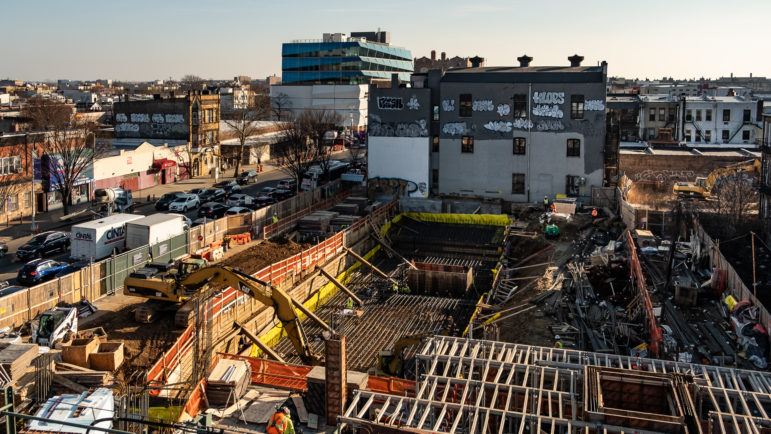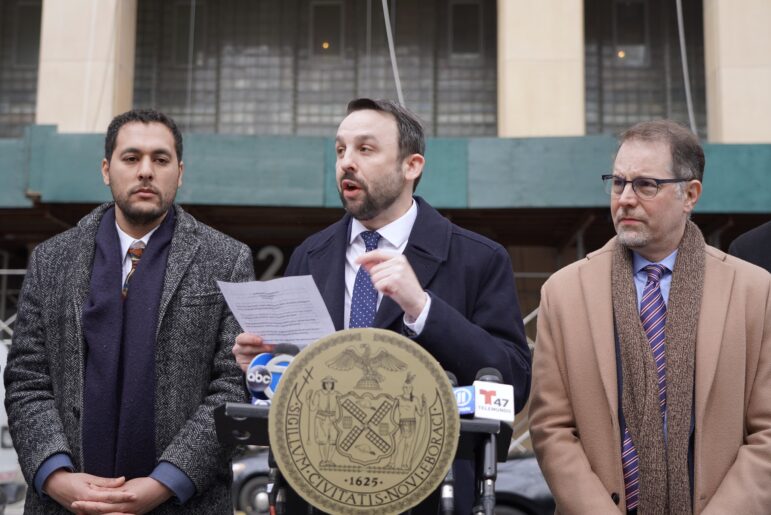
Adi Talwar
50 Pennsylvania Avenue, one of several affordable housing development sites in East New York under the city’s MIH program.Lynn Ellsworth’s Dec. 23 opinion essay (“It’s Time to End Mandatory Inclusionary Housing. Here Are Some Alternatives”) mistakenly calls the Mandatory program (MIH) a failure but does so based on both faulty data and a faulty analysis.
Ms. Ellsworth asserts that the city promised that the MIH program would deliver 80,000 affordable apartments but only delivered 2,000. No such promise was ever made. The promise of 80,000 new affordable dwellings was made in 2014 but relates to the total new construction anticipated over 10 years in the Mayor’s Housing New York Plan from all of the city’s programs. At the end of fiscal year 2020—seven years into the program—the city had financed just over 50,000 new units. That’s a little off the pace needed to get to 80,000 newly-built homes in 10 years but comfortably within reach of exceeding 70,000. Falling short of the goal by 10 percent or so may not be a point to brag about but adding over 7,000 new affordable apartments a year is a pretty remarkable accomplishment.
Apartments produced under MIH are part of that 80,000 but were never intended to comprise more than a small share of that number. The MIH program, first adopted in 2016, is only applicable in areas that are rezoned and the first rezoning—East New York—was approved only in 2017 with other rezonings following in subsequent years. Together, these area-wide rezonings constitute a very small share of the city’s area. In addition, there have been a fair number of private rezoning applications that cover small areas but also come with an MIH requirement. Through fiscal year 2019, the MIH program in both city-initiated rezoning neighborhoods and the smaller private rezonings, have already led to over 6,000 new and permanently affordable units which is more than three times the number Ms. Ellsworth claims.
Ms. Ellsworth ignores the importance of time. It takes time to initiate rezonings and get them through the public review process. It takes more time after such rezonings, for all the steps to getting a development approved and built. It is almost impossible for rezonings completed in 2017, 2018 or 2019 to have produced an enormous amount of completed housing. Nevertheless, these rezonings are producing over 6,000 affordable apartments so far with more likely to come.
The opinion essay also errs in asserting that MIH “mostly enriches developers and real estate speculators while inflicting real harm to the neighborhoods it’s supposed to help.” To the contrary, a Manhattan Institute report by Eric Kober found that, because the de Blasio-era city-initiated rezonings were predominantly in less affluent neighborhoods, there was little market-rate development in these areas. In East New York, the Kober study found that there was none: all of the buildings contained 100 percent affordable housing.
If all the housing may be affordable anyway, you may ask, “Why is MIH necessary?” There are several answers. One is programmatic in that Department of City Planning requires that all areas rezoned to permit apartment houses must include permanently affordable housing. Thus, whatever the future may bring and for as long as the housing stands, the specified percentage of affordable housing must remain even if the public subsidies used for the development have long since run out and the remainder of the building has been converted to market-rate housing. In such a scenario, it will be the market-rate housing that will provide the ongoing subsidy to keep the MIH units affordable. Many of the privately-initiated rezonings (and some of the city-initiated ones such as Gowanus) are in communities where the marketplace will support new development. MIH captures some of the profit from these market-rate developments to subsidize permanently affordable housing. Given the city’s pandemic-weakened economy and its diminished tax revenues, this source of subsidy will continue to be important.
The implication of Ms. Ellsworth’s essay is that market-rate housing is bad and is falsely sold as a way of trickling down older housing to the less affluent. She has it backwards. In New York City—for at least the past four decades—the shortfall in housing production has resulted in a market pushing up the price of existing housing to the substantial detriment of the less affluent. Her scheme to cap development can only make matters worse were it to become public policy.
As one of the authors of the 1987 Quality Housing zoning amendment that allowed for the city’s ubiquitous six-story apartment house to once again be built in large numbers, I agree that it is a fine housing type. Although it is substantially more expensive per square foot than the low-rise, no-elevator row houses that had been dominating new construction outside of Manhattan for more than two decades prior to 1987, it is a relatively inexpensive apartment house to build. She is wrong, however, about taller buildings. Because they may use similar building technology, costs per square foot are not significantly better for producing a six-story building than producing, say, a 10-story building. But producing 30 or 40 percent less housing has a dramatic effect on constraining the supply of housing and hence driving up the price of housing for everyone.
It may be convenient for some who are already housed to say the city does not need more housing or not much more housing. Virtually four hundred years of the city’s history suggests otherwise.
Sandy Hornick is the Principal of Hornick Consulting, Inc.
Lynn Ellsworth, the author of the aforementioned opinion piece published Dec. 23, responds:
Nothing Ms. Hornick says refutes my arguments that MIH fails, and that upzoning with towers are problematic ways to create affordable housing. It is also false to suggest I say that the city does not need more housing! We just disagree how to go about it. My alternatives are targeted at the bottom of the market where the need is greatest — if adopted from the get-go we’d likely already have more units than what MIH has produced.
On specifics:
1. The figure of 2,000 units from MIH comes from city responses to a state senator in a videotaped hearing of November 2019.
2. Market-rate housing in up-zoned areas is indeed sold as a trickle-down way to lower housing prices. Ms. Hornick is conflating that with the idea of filtering.
3. Housing prices prior to COVID cannot be disentangled from several things. Among them: the effect of global, speculative real estate capital pouring into NYC; the reality that there is nowhere to build in the historic core without demolition; and the downzoning of the outer periphery of the city.
4. Six-story buildings have unheralded virtues. One, they don’t provoke the pervasive hostility to towers. Two, as one can observe in Williamsburg, they can be built affordably to house people with Section 8 vouchers. Third, they have the virtue of better preservation and equitable distribution of the sky-dome, a virtue tower advocates trivialize.
5. Glad to hear that the city “financed” 50,000 units in non-MIH programs. Does “financed” also mean “built”?
This story was updated on Jan. 6, 2021 to include the following statement from Hornick, in response to Ellsworth‘s statement:
1. Completely refuted:
- Your assertion that MIH fails because it is not producing the promised levels of housing because there was no promised levels and the actual production is far greater than you cited and
- that six-story buildings are cheaper to build.
2. The deBlasio administration’s limited discussions of market-rate housing can be summed up with: the absence of new supply drives prices up, and that new supply helps ease upward pressure on prices. Nothing about “trickle-down.”
3. The pandemic-induced drop in housing demand has resulted in a reported 13 percent drop in Manhattan rents with bigger drops in other cities. So readjusting the ratio of supply and demand does work.
4. The less fortunate need subsidies and MIH is one source of subsidies.
5. Flows of capital have always been essential to the construction of apartment houses and most city residents of multi-family housing live in buildings that were built with speculative capital. The flow of capital into the city’s housing is a reflection of its value not the cause of the value.
6. The point of rezonings is that there can be many opportunities to redevelop new housing and increase supply (and generate affordable housing) without doing violence to the character of communities.
7. While we both want to improve housing for the poor, the city cannot get more of it by restricting the supply of housing. I’m willing to give up some of the “sky dome” to get more people housed.
8. Drinks someday, Lynn?









9 thoughts on “Opinion: In Defense of Mandatory Inclusionary Housing”
Never forget when this kind of hot garbage comes up that Manhattan alone currently has more vacant apartments (including rentals and condos) than homeless families in the city. First developers cry about regulation, arguing that they should be able to build out indefinitely, but they only build to the top of the market so when naturally rents rise and families are pushed out — because the affordability just doesn’t trickle down — then they whine about not being sufficiently subsidized by the city to build for middle income families. In other words, they want to have their cake and eat it too and will use every baked over Reaganomics argument to get it.
Kudos to Lynn Ellsworth for calling this nonsense out!
Land and labor are very expensive everywhere in NYC. I live on SI and we are the furthest from Manhattan, with no subways, so you’d think homes would be very cheap out here. They’re not, because of the land and labor issue I noted above. New 2-family homes sell in the $1M range which is ‘affordable’ compared to the rest of the city.
For example $1,070,000 for a new 2-fam – –
https://www.compass.com/listing/232-8-street-staten-island-ny-10306/368044991693135345/
So just imagine what it costs to put up an apartment building in NYC.
Rezoning unused commercial and manufacturing areas is another way to provide more affordable housing.
An example of this would be the potentially largest building in the world, straddling the East River between (expensive) Dumbo/Vinegar Hill, and modestly-priced Two Bridges: The RiverArch.
Featured in The Broadsheet a year ago: http://bit.ly/BroadsheetRA1, the RiverArch would provide 30.14%/2,300 units of affordable housing @50% discount in price and rent to market rate units, in perpetuity. If we can get LIHTC to cover the boost to 40% required under that program, we would build that amount of housing instead, over 3,000 units, or more than the entire amount Ellsworth cites under MIH rules to date, in just a single building housing over 19,000 residents, with nearly a million sf of commercial space and a 900-student high school, provided free to the city.
The “RiverArch plan” is the kind of outside-the-box the city needs now to meet both its housing needs, and the need for capital to be attracted to risky developments – we do not have city, state, federal permission yet, to build over-the-river. Capital always balances risk and return. If a project is deemed to risky, capital goes elsewhere, and everyone loses. On the other hand, if risk can be mitigated by economies of scale and modular construction – both of which the development parties plan to use for the RiverArch – capital will be attracted to the project, but only if the public authorities are willing to be creative, and the neighborhoods are willing to see benefit when it is actually offered. Pulling up the drawbridge when one is housed deprives the city of growth and opportunity, and those, like capital, will then go elsewhere.
– Scott Baker,
Originator & Designer of the RiverArch
Trickle down economics have never worked. It’s also never been a matter of scarcity, it’s a matter of real estate developers and owners hoarding resources.
https://www.doria.fi/bitstream/handle/10024/181666/vatt-working-papers-146-city-wide-effects-of-new-housing-supply–evidence-from-moving-chains.pdf?sequence=1
“The supply of new market rate units triggers moving chains that quickly reach middle- and low-income neighborhoods and individuals. Thus, new market rate construction loosens the housing market in middle- and low-income areas even in the short run.” This is just the most recent in a large body of research arriving at the same conclusion.
https://research.upjohn.org/up_workingpapers/307/
Supply and demand are in fact real things, and housing does in fact trickle down.
In fact nearly everything in New York was built by private developers, as market rate property. If you want housing to be cheaper, you need more market rate development so renters aren’t forced to bid over each other.
Fun fact: even high income people who can afford a $4k/month apartment, don’t want to pay 4k/month for a 1 bedroom apartment.
‘…but they only build to the top of the market…’
Land and labor are expensive all over the city. I live on S.I., which is the furthest from NYC, and without subways. So you would think that homes would be very cheap out here. Guess again. New 2-family homes sell in the $1M range which is ‘affordable’ in NYC’s home market. So imagine what it costs to put up an apartment building, that’s why developers in NYC have to build for the high end. Land and labor can’t be made cheaper.
For example $1,070,000 for a new 2-family –
https://www.compass.com/listing/232-8-street-staten-island-ny-10306/368044991693135345/
3. Housing prices prior to COVID cannot be disentangled from several things. “…and the downzoning of the outer periphery of the city….’
The Bloomberg downzinings of 2005-2006 saved the east shore of Staten Island.
Alas, Sandy, I do not think you have won this argument.
1. I stand firm on the quality of my data sources for the 2000 MIH units produced as of December 2019. My source is a public hearing called by the State Legislature on Affordable Housing. You give no source for your figure of 6000.
2. Even if 4,000 new MIH units came on-line during 2020 Covid, MIH is still a fail. It just cannot produce the numbers needed and the negative externalities of the program are too great.
3. If other city non-MIH programs produced 50,000 units, I would be glad, and I did not criticize other programs that were not MIH. However, you say 50,000 units were “financed” not produced. There is a big difference. Gotta be very careful on what words one uses.
4. My trickle-down argument is rock solid, and you did not manage to undermine it. It is the very theoretical underpinning of MIH according to no less than Ed Glaeser.
I’ll take the winning score here, but will certainly accept the drink.
Ceo Renee Mitchell of Breaking The Cycle Drop Corp. Said that they should just create low income housing. Directly for low income working poor. Cause affordable housing in Nyc is not affordable especially if your medium income starts at 66,000 the government is not working to help the people. Its a massive system failure.